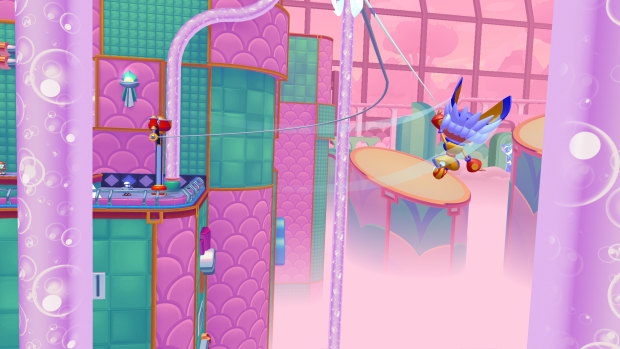[ad_1]
“I was always very keen to add new special features, and with each game Sega graciously trusted me to go a bit further each time.”
Loading
In 2013, the first Sonic came to phones, now complete with the ability to play as Tails and Knuckles, the hedgehog’s friends from subsequent games. Sonic 2 followed, and in this version Whitehead and his collaborators had also managed to reinstate the Hidden Palace Zone, a section removed from the original game that had become mythical to the internet’s Sonic fans. The popularity of these apps helped convince Sega’s higher-ups that the demand was there for old-school Sonic.
“Working with Sega on those games, there was always staff there that were interested in bringing classic pixel 2D Sonic back with a new game,” Whitehead said.
“But it wasn’t until early 2016 when things just came into alignment, and we were able to successfully pitch Sonic Mania.”
Part remake and part entirely new game, Mania is a love letter to classic Sonic, which was released as a download-only game for consoles in 2017 to rave reviews. Powered by the Retro Engine, it remains the highest-rated console Sonic of all time on aggregator site Metacritic, and received an expanded physical release in 2018 which — true to Whitehead’s M.O. — added the ability to play as two of Sonic’s long-lost friends.
With Evening Star formed shortly afterwards, Whitehead said the shift from working on one of the world’s most recognisable series to being creative director of a new studio was a profound one.

Evening Star, developer of Penny’s Big Breakaway, is based across three continents.
“It’s absolutely freeing, and therein lies the challenge. A property holder will typically tell you what you can and can’t do with the characters, lore, even down to specific emotions or colour usage. But with an original property, all these elements need to be discovered and defined for the dev team to maintain a cohesive vision,” he said.
“External to that, you also have to convince your audience they should care about your new game and its cast of characters. No matter the outcome, doing all this is immensely satisfying from an artistic viewpoint.”
Set in the pastel world of Macaroon, a monarchy where status is decided by your skill as a performer, Penny’s Big Breakaway is a slick 3D platformer all about using various yo-yo tricks to jump, roll, swing and boost your way through the various levels. Fittingly, given the developers are well-versed in creating levels in 2D and are now moving to three dimensions, the whole thing has strong early 2000s vibes, evoking transitional platformers like Ape Escape, Banjo Kazooie, Jet Set Radio or Billy Hatcher. That also follows through to the soundtrack; a quirky, energetic and ever-changing mix of squiggly synths and samples.
Our hero Penny has unexpectedly had her yo-yo transformed into a creature with a mind of its own, which causes an uproar when it attacks the Emperor at an important audition. The bulk of the game, then, is an escape from the Emperor’s constabulary; idiot penguins who bumble around the levels and try to slow you down.

Though it features an unusual control scheme and yo-yo-based movement, Penny’s Big Breakaway is designed for both beginners and hardcore speed-runners.
“We wanted to take a different approach and have an enemy type that is harmless on its own, but will drag you down if you get mobbed by too many of them,” Whitehead said.
“Penguins were a fun choice because they are essentially squishy bowling pins for the player to knock out of the way to avoid getting captured. This also kept our gameplay focused on movement rather than combat.”
Each level is smartly layered not just to ensure players of different skill levels have a good time, but to encourage beginners to expand their horizons. Little bystanders have funny things to say when you walk by, but may also give you a quest that has you explore the level. In hidden nooks you might find collectible coins, and those can be cashed in to access secret levels that teach you advanced yo-yo manoeuvres. Of course, as you may expect, going fast is something absolutely embraced by this game, and with some practice, you’ll have Penny absolutely blazing.
Loading
Aesthetically, Whitehead points to influences as varied as athleisure and the Bauhaus classic Triadic Ballet for the game’s art style, but part of the unique look and feel is also down to the technology behind the scenes. While the majority of games, especially those made by smaller teams, use off-the-shelf development tools like Unity or Unreal, PBB uses the Star Engine, created by Whitehead at Evening Star.
“Retro Engine taught us the value of a lean and minimalistic development ethos, something that is hard to get with a general-purpose engine,” he said.
“We want to focus on stylistic 3D games, sidestepping heavier elements demanded of workflows focused on realism.”
Penny’s Big Breakaway is out now for PC, PlayStation 5, Switch and Xbox Series X/S.
Get news and reviews on technology, gadgets and gaming in our Technology newsletter every Friday. Sign up here.
[ad_2]
Source link

